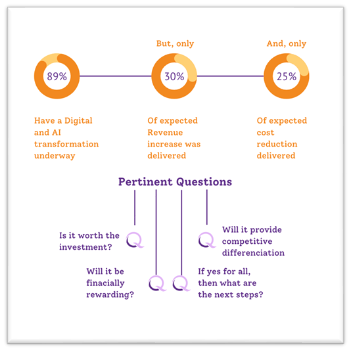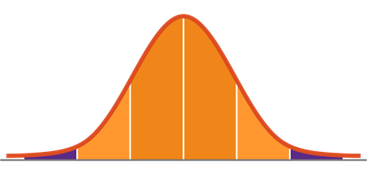In today’s fast-moving digital world, no company can afford to miss the bus of digital transformation. With rapidly moving market, existence of businesses comes into question if they fail to digitally transform themselves to compete and capture new markets. But as the world is rapidly moving towards digital transformation, with the constraints of resources are they getting the expected outcome/ROI? Are they able to make the required impact on all the stakeholders?

The above study by McKinsey’s digital practice clearly states that although 89% of the business are or have undergone business transformation and as an end result only 30% of them got the expected revenue increase, 25% of them could got the expected cost reduction, strange, right? Surely there is something in this approach that is clearly missing. What is the magic ingredient that ensures that the organization gets the anticipated outcome of the digital transformation? Well, there is no single ingredient but a collective contribution of “all” stakeholders of the organization and when we say all it is literally all; any one missing either by intent, design or capabilities can cause less than expected outcomes from the transformation. Below are few of the findings that can help organizations to ensure they are in the journey with all the right intent, plan, technology and team.
Purpose
One of the major reasons for failure is that the “Purpose” of the digital transformation is not clear, consistent or carefully governed. Top guns of the organization play a vital role as the “Why” comes from them. When we connect technology to a profound sense of purpose, we unlock its true potential and embark on a journey of meaningful progress, not just technological advancement. A well-crafted purpose shall help the organizations visualize, define and document who will they be post the transformation and align all levels of the organization. Purpose simplifies and binds the organization as often transformations tend to go directionless.
Change management
Changing and running at the same time always needs balance and thus change management cannot be avoided. A well-defined purpose clears way for top-down communication and reduces the risks of change management. The holistic approach to address the end-to-end business alignment and not the immediately impacted areas shall ensure business readiness and faster adoption. Resistance to change can be avoided if during the transformation, the front liners are involved, as they have insights into customers’ pain points and the solutions that can be levered. Going beyond traditional skills training and nurturing a culture of continuous learning is the key. Upskilling and reskilling the existing workforce shall ensure early and easy adoption. The most effective way to embrace change is by involving the top management in business process change, tech awareness etc. Before, during and after the transformation.
Approach
To optimize performance and impact, organizations must engage in rigorous self-assessment, scrutinizing their team composition, technological assets, financial constraints, and timeframes. Post-goal analysis enables informed prioritization between “Big Bang” transformations and siloed improvements, fostering learning and adaptation. The focus? Internal or frontline systems? Global or regional implementation? The answer lies in a nuanced blend driven by a holistic understanding of micro and macro factors. Ultimately, success hinges on striking a balance that maximizes value creation, elevates customer experience, and ensures business feasibility, scalability, and technological readiness. This comprehensive approach empowers organizations to navigate uncertainty and achieve impactful, sustainable progress.
Technology and talent
The digital revolution has irrevocably altered the landscape of every industry, and at the heart of this seismic shift lies technology. Far from being merely tools, cutting-edge technologies like AI, ML, IOT & Big Data are the very engines driving digital transformation, propelling organizations towards unprecedented levels of efficiency, adaptability, and customer engagement. This isn’t just about replacing analog processes with digital equivalents. It’s about reimagining workflows, disrupting outdated models, and fostering a culture of continuous innovation. Technology provides the foundation upon which organizations can build new value propositions, enhance existing products and services, and forge deeper connections with their customers. Technological innovations are individual pieces in a complex Digital Transformation puzzle, powerful but incomplete. It’s the human talent – the architects, analysts, builders, and navigators – who understand how these pieces fit together, who bridge the gap between potential and reality. Their expertise in data analysis, cloud architecture, user experience design, and agile methodologies are the brushstrokes that paint the canvas of a successful transformation. Think of tech as the enabler, talent as the artist: think of the digital platform as a blank canvas. It offers possibilities, but without the artist’s vision and brushstrokes, it remains just an expanse of white. Talent, with its skillsets and creativity, transforms that canvas into an immersive digital experience, talent breathes life into technology, making it sing. The organizations need to either upskill or reskill, attract and retain new talent or partner to ensure they have the right talent.
Most common mistake made by the organization is the assumption that digital transformations are short lived, digital transformation is not a destination; it’s a permanent state of evolution. The point isn’t to become digital; it is to generate value for the business. And that can only happen if top management act as digital guardians of their companies’ transformations and are clear on how they can best affect the change that will embed digital DNA into their organizations.


